
|
Folk Dance Federation of California, South, Inc.
|
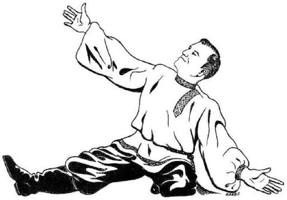
|
CLICK AN IMAGE TO ENLARGE
Readers will find the Russian words
РАЗ (one),
И (and),
ДВА (two),
ЗАТАКТ (beginning position),
ИСХОДНОЕ ОДОЖЕНИЕ (original support)
under the illustrations.
Prysiadkas are the most typical and principal characteristic of both Ukrainian and Russian dance. They are by no means the monopoly of these two countries, as they are also found in the dances of other countries; but there they play only a minor part and are hardly ever identified with them. It is only in the dances of Russian and Ukraine that they have achieved unusual significance and expression. As the cultural relations between Russian and Ukraine increased, the individual traits of the various prysiadkas blended, until now it would take a special authority to distinguish which is Ukrainian or Russian.
Prysiadkas can be divided into two categories – full and half. In the full prysiadka, the steps are eecuted while the body remains in squat position. In the half prysiadka, the various steps are done befor eand after the squat position.
Posture is of primary importance in the prysiadkas. The back muste be erect, straight, and rigid. There should be no round shoulders or hunching up during the step. Yet, with this rigidity of the spine, the step must flow with ease and suppleness. Far better to master one prysiadka with straight spine, ease of action and proper style, than to suffer through several prysiadkas sloppily done.
Proper preparatory exercises can only help the dancer limber up before attempting prysiadkas. One should never go into a prysiadka cold. Strained and torn ligaments can result. The thigh, hip, and back muscles, plus knee joints, are used in prysiadka and should be kept limber. Beginners should hold on to a bar or the back of a chair during first attempts in order to help maintain their balance.
In recent years many of the prysiadkas have been adopted for use on the stage, These have had various embellishments added to make them even more spectacular. But we are concerned here only with the 'native' prysiadkas.
An easy prysiadka with which to start is shown in Figure 1. It is done by leaping ointo the air and coming down in a full squat on the balls of both feet, with knees spread far apart. With another leap come down on the ball of the left foot and swing the right foot out to the side. Repeat, alternating feet.
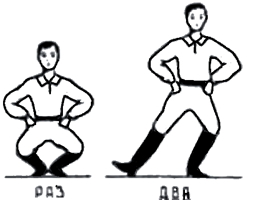
Fig. 1
Another interesting half prysiadka is shown in Figure 2. After the full squat the dancer does an toe and heel step. Be sure to turn the body as in the illustration to acquire the proper style. Alternate feet after each squat.
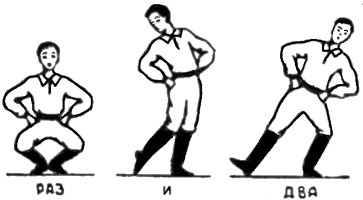
Fig. 2
A similar half prysiadka is shown in Figure 3. This time the daner lands on both toes after the squat, then with another leap lands on both heels.
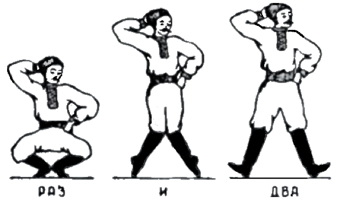
Fig. 3
Figure 4 shows prysiadka that can be done from a semi-squat or full squat position.
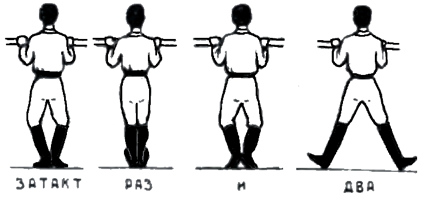
Fig. 4
Figures 5 and 6 show some other variations of the half prysiadkas.

Fig. 5

Fig. 6
A typical Ukrainian prysiadka is shown in Figure 7. It is called metelka, which means "broom," probably because of the sweeping motion of the knees as they brushed the floor.
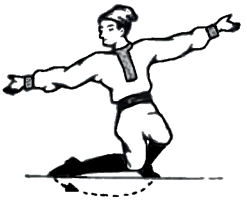
Fig. 7
The full prysiakda shown in Figure 8 is called the schupak in Ukrainian. There are two versions of it. One is where the legs are shuffled forward only half way in quick alternate movements. The more difficult version is shown in the last two diagrams of the series. Here the legs are thrust forward at full length. The trick is to maintain one's balance on the ball of one foot while the other is being thrust out. This is most popular of all prysiadkas and the one most commonly seen.
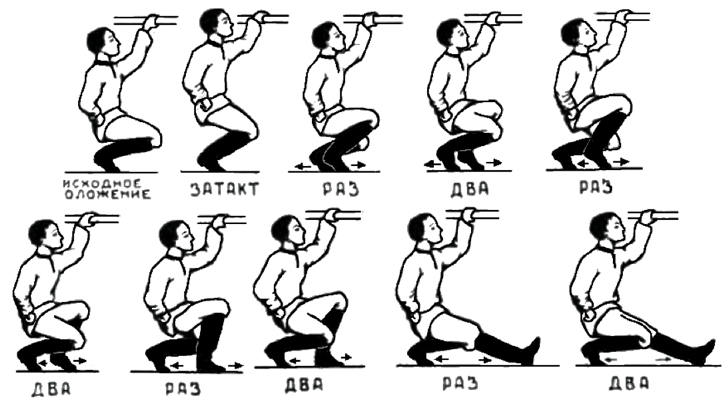
Fig. 9
Figure 9 shows another popular prysiadka. Here the dancer leaps into the air after the full squat and lands on both heels. Really adept dancers can execute a full turn on the ball of one foot after the full squat, then leap into the air and land on both heels.
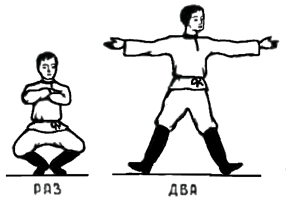
Fig. 9
This article, a free translation from the Russian book "Osnowy Kharakternoho Tancia,"
appeared in the April 1944 issue of The Folk Dancer, edited by Michael Herman
as well as the April 11, 1973 issue of Let's Dance magazine.